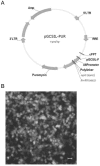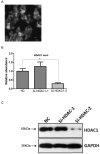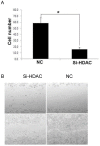Lentivirus-mediated Knockdown of HDAC1 Uncovers Its Role in Esophageal Cancer Metastasis and Chemosensitivity
- PMID: 27698906
- PMCID: PMC5039390
- DOI: 10.7150/jca.15086
Lentivirus-mediated Knockdown of HDAC1 Uncovers Its Role in Esophageal Cancer Metastasis and Chemosensitivity
Abstract
Histone deacetylationase 1 (HDAC1) is ubiquitously expressed in various cell lines and tissues and play an important role of regulation gene expression. Overexpression of HDAC1 has been observed in various types of cancers, which indicated that it might be a target for cancer therapy. To test HDAC1 inhibition for cancer treatment, the gene expression of HDAC1 was knockdown mediated by a lentivirus system. Our data showed the gene expression of HDAC1 could be efficiently knockdown by RNAi mediated by lentivirus in esophageal carcinoma EC109 cells. Knockdown of HDAC1 led to significant decrease of cell growth and altered cell cycle distribution. The result of transwell assay showed that the numbers of cells travelled through the micropore membrane was significantly decreased as HDAC1 expression was knockdown. Moreover, HDAC1 knockdown inhibited the migration of EC109 cells as determining by scratch test. Additionally, enhancement of cisplatin-stimulated apoptosis was detected by HDAC1 knockdown. Our data suggested inhibition of HDAC1 expression by lentivirus mediated shRNA might be further applied for esophageal cancer chemotherapy.
Keywords: EC109 cells; chemosensitivity; histone deacetylationase; lentivirus.
Conflict of interest statement
The authors have declared that no competing interest exists.
Figures





Similar articles
-
Enhanced radiosensitivity of EC109 cells by inhibition of HDAC1 expression.Med Oncol. 2012 Mar;29(1):340-8. doi: 10.1007/s12032-010-9559-3. Epub 2010 May 13. Med Oncol. 2012. PMID: 20464640
-
Effects of siRNA-Mediated Knockdown of HDAC1 on the Biological Behavior of Esophageal Carcinoma Cell Lines.Med Sci Monit. 2016 Apr 18;22:1291-6. doi: 10.12659/msm.895853. Med Sci Monit. 2016. PMID: 27086779 Free PMC article.
-
Lentivirus mediated GOLPH3 shRNA inhibits growth and metastasis of esophageal squamous cancer.Asian Pac J Cancer Prev. 2013;14(9):5391-6. doi: 10.7314/apjcp.2013.14.9.5391. Asian Pac J Cancer Prev. 2013. PMID: 24175832
-
[Knockdown of NEDD9 inhibits the proliferation, invasion and migration of esophageal carcinoma EC109 cells].Xi Bao Yu Fen Zi Mian Yi Xue Za Zhi. 2016 Dec;32(12):1662-1666. Xi Bao Yu Fen Zi Mian Yi Xue Za Zhi. 2016. PMID: 27916098 Chinese.
-
Knockdown of TGIF attenuates the proliferation and tumorigenicity of EC109 cells and promotes cisplatin-induced apoptosis.Oncol Lett. 2017 Dec;14(6):6519-6524. doi: 10.3892/ol.2017.7009. Epub 2017 Sep 21. Oncol Lett. 2017. PMID: 29344116 Free PMC article.
Cited by
-
Preclinical assessment of histone deacetylase inhibitor quisinostat as a therapeutic agent against esophageal squamous cell carcinoma.Invest New Drugs. 2019 Aug;37(4):616-624. doi: 10.1007/s10637-018-0651-4. Epub 2018 Aug 31. Invest New Drugs. 2019. PMID: 30168013
-
AR-42: A Pan-HDAC Inhibitor with Antitumor and Antiangiogenic Activities in Esophageal Squamous Cell Carcinoma.Drug Des Devel Ther. 2019 Dec 19;13:4321-4330. doi: 10.2147/DDDT.S211665. eCollection 2019. Drug Des Devel Ther. 2019. PMID: 31908417 Free PMC article.
-
Trichostatin A enhances radiosensitivity and radiation-induced DNA damage of esophageal cancer cells.J Gastrointest Oncol. 2021 Oct;12(5):1985-1995. doi: 10.21037/jgo-21-560. J Gastrointest Oncol. 2021. PMID: 34790366 Free PMC article.
-
Histone deacetylase 1 induced by neddylation inhibition contributes to drug resistance in acute myelogenous leukemia.Cell Commun Signal. 2019 Jul 29;17(1):86. doi: 10.1186/s12964-019-0393-8. Cell Commun Signal. 2019. PMID: 31358016 Free PMC article.
-
Foretinib Enhances the Radiosensitivity in Esophageal Squamous Cell Carcinoma by Inhibiting Phosphorylation of c-Met.J Cancer. 2017 Mar 12;8(6):983-992. doi: 10.7150/jca.18135. eCollection 2017. J Cancer. 2017. PMID: 28529610 Free PMC article.
References
-
- Wagner T, Brand P, Heinzel T, Krämer OH. Histone deacetylase 2 controls p53 and is a critical factor in tumorigenesis. Biochim Biophys Acta. 2014;1846(2):524–38. - PubMed
-
- Højfeldt JW, Agger K, Helin K. Histone lysine demethylases as targets for anticancer therapy. Nat Rev Drug Discov. 2013;12(12):917–30. - PubMed
LinkOut - more resources
Full Text Sources
Other Literature Sources
Miscellaneous

